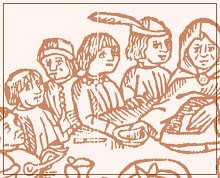For reference, this is the full text of the poetic exchange on the page discussed in the last post (BL Add 37049 20r). Couplets are compressed onto one line for space, line breaks indicated with /. The only punctuation is an occasional medial punctus, transcribed as a full stop. Maiuscules follow the manuscript. Abbreviations are expanded with italics. The scribe made a few errors in the final lines (were they obscured in his original?) and has crossed them out, possibly with some attempt at scraping or rubbing – it’s hard to say on the colourless image. On the first two occasions he crossed the letters out before completing the word and continued on the same line, while on the third he completed the line before realising his mistake and inserted a superlinear correction.
Querela diuina
O man vnkynde / Hafe in mynde
My paynes smert
Beholde and see / Þat is for þe
Percyd my hert
And yitt I wolde / Or þan þu schuld
Þi saule forsak
On cros with payne / Scharp deth agayne
Ffor þi luf take.
Ffor whilk I aske / None oþer taske
Bot luf agayne
Me þan to luf / Althyng abofe
Þow aght be fayne
Responsio humana
O lord right dere / Þi wordes I here
With hert ful sore
Þerfore fro synne / I hope to blynne
And grefe no more
Bot in þis case / Now helpe þi grace
My frelnes
Þat I may euer / Do þi pleser
With lastyngnes
Þis grace to gytt / Þi moder -eh- eke
Euer be –þry- prone
Þat we may alle / In to –þat- \þi/ halle
With ioy cum sone
Amen.
The words around the wound in the heart:
Þis is þe mesure of þe wounde þat our / Jhesus crist sufferd for oure redempcoun [sic – I just can’t make out an i anywhere in there!]
Christ’s words:
Þies woundes smert. bere in þin hert and luf god aye. / If þow do þis . þu fil haf blys with owten delay
Incidentally, the scribe originally started writing this verse higher on the page, stopping when he realised that the words would run into Christ’s halo. There seems to be an attempt at scraping the first attempt away, and the line enclosing the text banner is thicker over the half-erased words in an attempt to hide them. It’s probably not to much of a jump to hazard that the scribe was also the illustrator, and didn’t do anything very elaborate in the way of plotting out his page layout beforehand. I think we also have an indication that he was thinking about the illustrative rather than the poetic side of things when copying out the second line of this couplet, in that he (automatically?) added the usual “en” to “withowten”: it rather destroys the rhythm, and could have been omitted.


.jpg)


2 comments:
Hello - thanks for this! I'm currently working with Hogg's black & white facsimile of Add. 37049 which is so small as to make transcription difficult. I could call up any of the few printed versions of the text but a quick google brought this up - thanks again.
Delighted to hear it! That's always my hope when I post any of this unpublished material on my blog, after all. Lovely to hear it's being useful.
Post a Comment